The Michael E. Moody Lecture Series
“The Meaning and Meaningfulness of Mathematics”
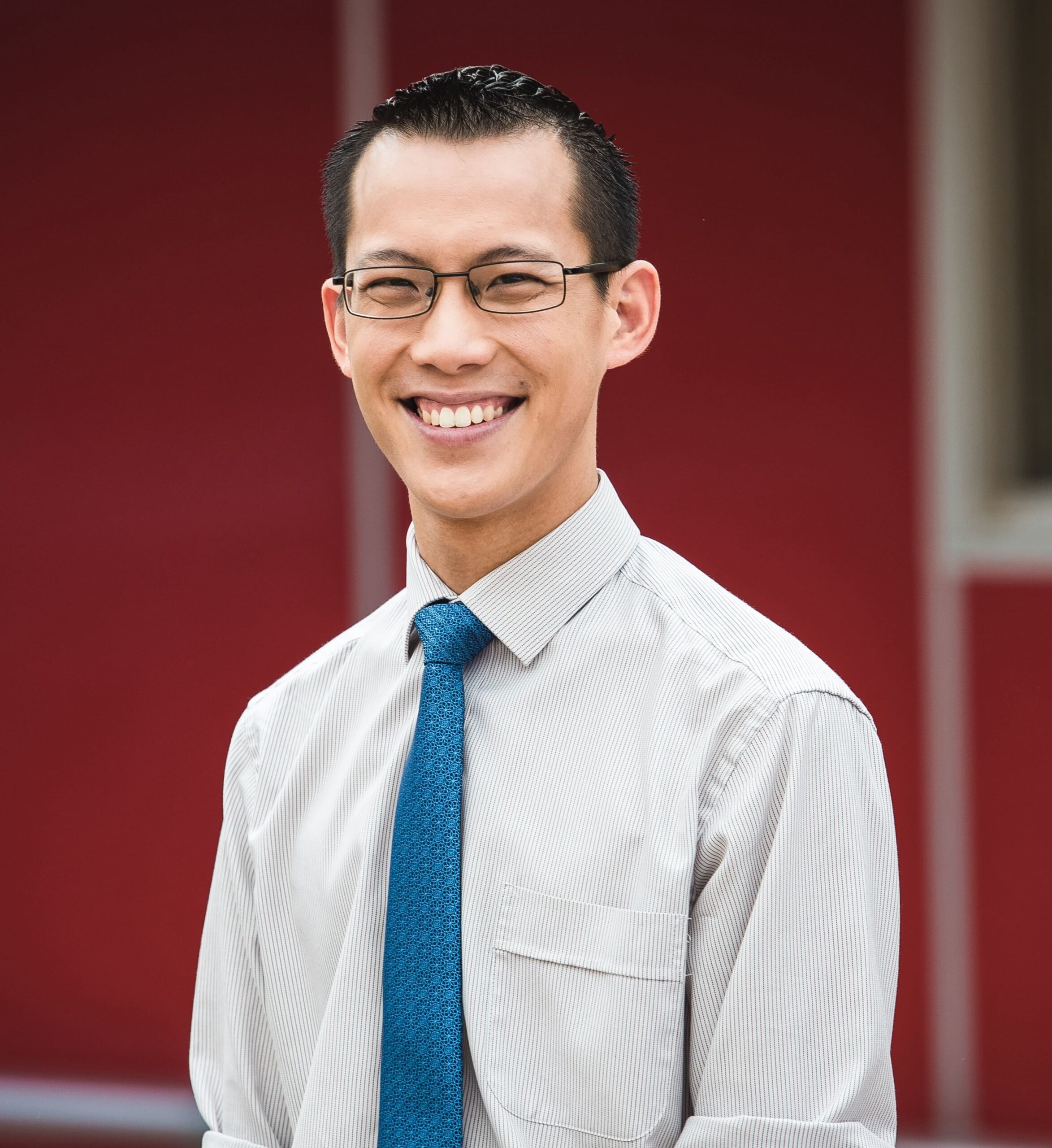
Eddie Woo presents the 22nd lecture in the Michael E. Moody Lecture Series.
Eddie Woo teaches mathematics at Cherrybrook Technology High School. His YouTube channel, Wootube, has more than 1.8 million subscribers and 170 million views of his everyday classroom lessons. Within the New South Wales Department of Education, he leads the Mathematics Growth Team, a statewide program of instructional leaders focused on engaging and evidence-informed teaching practices. He is a professor of practice at the University of Sydney, working with preservice teachers in the Sydney School of Education and Social Work. In 2018, he was named Australia’s Local Hero in the Australian of the Year Awards and listed as one of the Top 10 teachers in the world by the Global Teacher Prize. He is a TED speaker, a children’s TV host and the author of It’s A Numberful World.
This lecture took place on November 11, 2024 at 7p.m., in HMC’s Shanahan Center Auditorium.
Abstract
Temple University mathematics professor John Allen Paulos said, “Mathematics is no more computation than typing is literature.” But the mainstream view of mathematics in the world is that math is comprehensively described by numbers, calculations, equations and formulas. This narrow understanding is often what lies underneath many of the misconceptions about math as well as the widespread dislike of the subject.
It is often why—to the average person on the street—math feels abstract, disconnected and meaningless. This lecture will explore ways to help broader society see mathematics as meaningful, by expanding the meaning of mathematics in their minds. Mathematics is found everywhere and is for everyone, but people can only access it if they truly understand what it is all about. Educators have both the privilege and responsibility to help others along that journey.
Spring 2024, Tai-Danae Bradley
“Category Theory: The Mad Libs of Mathematics”
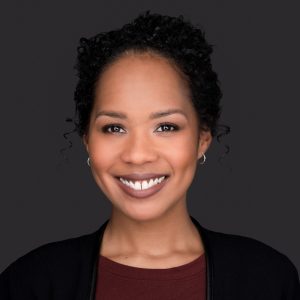
Tai-Danae Bradley presented the 21st lecture in the Michael E. Moody Lecture Series on “Category Theory: The Mad Libs of Mathematics.”
Tai-Danae Bradley is currently a research mathematician at SandboxAQ, a startup company focused on AI and quantum technologies, and a visiting research professor of mathematics at The Master’s University. She earned a PhD in mathematics from the CUNY Graduate Center in 2020 and afterwards spent time as a postdoctoral researcher at X, The Moonshot Factory (Google X). She is the creator of the mathematics blog Math3ma, as well as a coauthor of the graduate-level textbook Topology: A Categorical Approach and a former co-host of the PBS YouTube channel “Infinite Series”. Her research interests include category theory, machine intelligence, and quantum physics.
The lecture took place on April 3, 2024 at 7 p.m., in HMC’s Shanahan Center Auditorium.
Abstract
Mad Libs is a fun word game, played by filling in the blanks of a story with different words: nouns, verbs, adjectives, and so on. Different word choices result in different, sometimes comical, stories that are all related by a common template. In some ways, category theory can be thought of as the Mad Libs of mathematics. Originating in the 1940s, category theory provides a framework or “template” that unites many ideas, constructions, and themes across the mathematical landscape. A category theoretical viewpoint can also extend to disciplines outside of mathematics, providing new ways to think about new (and old) problems. Language itself is one example, as some ideas behind today’s large language models, like ChatGPT, seem to be pleasantly compatible with existing perspectives in category theory. In this talk, I’ll share more about these tantalizing connections, starting with a friendly introduction to this modern branch of mathematics.
Spring 2023, Grant Sanderson
“Where Math and Physics Collide”
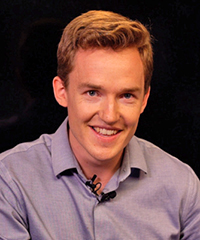
Grant Sanderson presented the 20th lecture in the Michael E. Moody Lecture Series on “Where Math and Physics Collide.”
Grant Sanderson is the author of the mathematics YouTube channel 3Blue1Brown, with over 4.8 million subscribers, and 250 million views. The channel is characterized by visualizations and animations that illustrate topics in math, ranging from lessons in linear algebra, neural networks, calculus, topology, algorithms, problem-solving, and more. He also created the open-source mathematical animation software manim, which powers the graphics behind 3Blue1Brown. He is arguably the most popular mathematician on YouTube with video topics ranging from engineering, physics and abstract math to quantum mechanics. Sanderson studied mathematics and computer science at Stanford University and has worked at Khan Academy and MIT, producing online courses and lectures. He’s contributed to numerous publications for mathematics outreach and education, including Quanta, Udacity, Manning and Numberphile.
The lecture took place on April 3, 2023 at 7 p.m., in HMC’s Galileo Auditorium.
Abstract
Grant Sanderson will explore a series of unexpected connections beginning with a simple question of two blocks colliding with each other, where an unexpected occurrence of pi pops up. Understanding what happens involves an unexpected tour through kinematics, optics and—with a little willingness to dive into the rabbit holes that present themselves along the way—quantum computing.
Fall 2020, Nadia Abuelezam ’09
“Injustice, Inequity, and Inequality: Lessons at the Intersection of Mathematics, Epidemiology, and Racism“
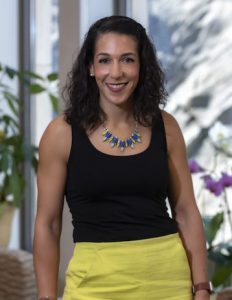
Nadia Abuelezam ’09 presented the 18th lecture in the The Michael E. Moody Lecture Series on “Injustice, Inequity, and Inequality: Lessons at the Intersection of Mathematics, Epidemiology, and Racism.”
Nadia N. Abuelezam, Sc.D. is an epidemiologist and assistant professor at the Connell School of Nursing. Dr. Abuelezam was trained in infectious disease epidemiology at the Harvard T.H. Chan School of Public Health. She graduated from Harvey Mudd College in 2009 with a B.S. in Mathematical Biology. She has expertise in mathematical modeling, data analytic approaches in public health, and mitigating health inequities for vulnerable populations. Her current research focuses on understanding health risks in hard to reach populations, including immigrants. The goals of her program of research are to use quantitative methods and novel data streams to better understand inequities in health outcomes and healthcare access in resource poor settings and vulnerable populations.
The lecture took place on October 21, 2020 at 4:15 p.m., in HMC’s Shanahan Center Auditorium.
Abstract
The COVID-19 pandemic has exposed existing health inequities for communities of color in the United States. Racism is a known structural cause of these health inequities. Counterfactuals are essential to our understanding of causal relationships in epidemiology, but how do you formulate a counterfactual for racism? This talk will explore the basis for counterfactual thinking in epidemiology and the ways in which we need to “re-imagine” counterfactuals to address one of society’s longest standing issues: racism.
Fall 2019, Francis Edward Su
“Mathematics for Human Flourishing”
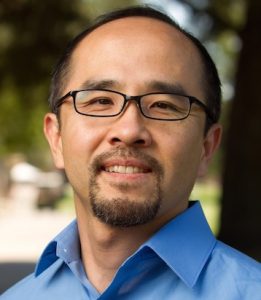
Francis Edward Su presented the 17th lecture in The Michael E. Moody Lecture Series on “Mathematics for Human Flourishing.”
Francis Edward Su is the Benediktsson-Karwa Professor of Mathematics at Harvey Mudd College and past president of the Mathematical Association of America. He received his B.S. in mathematics from the University of Texas at Austin and his PhD from Harvard University. His research is in geometric combinatorics and applications to the social sciences, and he has co-authored numerous papers with undergraduates. He also has a passion for teaching and popularizing mathematics. From the Mathematical Association of America, he received the 2018 Halmos-Ford award for writing, and the 2013 Haimo Award for distinguished teaching.
Su’s bookMathematics for Human Flourishing will be published by Yale University Press on Jan. 7, 2020. Yale Press and Huntley Bookstore will make early copies available for purchase and signing at the event.
More information on Francis Su is available on Francis’ professor website and his personal website.
The lecture took place on December 4, 2019 at 7 p.m., in HMC’s Shanahan Center Auditorium
Abstract
For many, math is lifeless and meaningless; a bunch of rules to follow; a way to separate people rather than a way to bring them together. It’s no wonder that many have anxiety over their math experiences. I believe more people would love math if they could see how it is intimately tied to what it means to be a human being and live a more fully human life. I’ll explain how math can (or should) meet basic desires that all human beings share, and builds virtues that serve each person well no matter what they do in life. A prison inmate has helped me see this more clearly than ever before.
Spring 2019, Matt Parker
“Stand-Up Comedian and Mathematician”
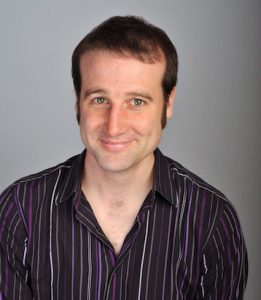
Matt Parker presented the sixteenth lecture in The Michael E. Moody Lecture Series in his role as a “stand-up comedian and mathematician.”
Matt Parker appears regularly on TV and online as well as being a presenter on the Discovery Channel. His YouTube videos have been viewed over 25 million times. Previously a maths teacher, he visits schools to talk to students about maths as part of Think Maths and is involved in the Maths Inspiration shows. As part of the comedy group Festival of the Spoken Nerd, he has toured worldwide and is the first person to use an overhead projector on-stage at the Hammersmith Apollo since Pink Floyd. Parker, the Public Engagement in Mathematics Fellow at Queen Mary University of London, is author of the books Things To Make and Do in the Fourth Dimension (Penguin, 2014) and Humble Pi, due for release this July.
More information on Matt Parker is available from Matt’s website.
The lecture took place on February 20, 2019 at 7 p.m., in HMC’s Shanahan Center Auditorium.
Abstract
The maths in our everyday lives works quietly behind the scenes—until someone forgets to carry a 1 and a bridge collapses, a plane drops out of the sky or a building rocks when its resonant frequency matches a gym class leaping to Snap’s 1990 hit “I’ve Got The Power.” In addition to contemplating math in our everyday lives, Matt Parker will discuss his latest book Humble Pi, which explores what happens when maths goes wrong in the real world. Parker explores and explains a litany of near-misses and mishaps involving the internet, big data, elections, street signs, lotteries and the Roman empire and shows us the bizarre ways maths trips us all up, and what this reveals about its essential place in our world. We would all be better off, he argues, if we saw maths as a practical ally so we can use it to our advantage and learn from its pitfalls.
Fall 2018, Frank A. Farris
“The Artful Mathematics of Wallpaper Patterns”
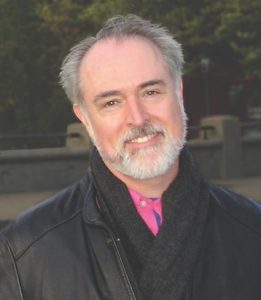
Professor Frank A. Farris presented the fifteenth lecture in The Michael E. Moody Lecture Series on “The Artful Mathematics of Wallpaper Patterns.”
Frank A. Farris, professor of mathematics and computer science at Santa Clara University, has served as editor of Mathematics Magazine and as the Mathematical Association of America chair of the Council on Publications and Communications. His book, Creating Symmetry: The Artful Mathematics of Wallpaper Patterns, was published by Princeton University Press in 2015.
More information on Frank A. Farris is available from Frank’s website.
The lecture took place on Nov. 2, 2018 at 7 p.m., in HMC’s Shanahan Center Auditorium.
Abstract
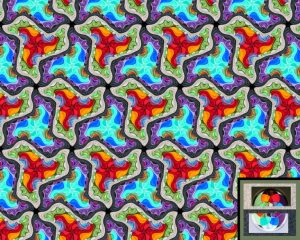
Frank A. Farris introduced his method of creating wallpaper patterns using complex-valued, doubly-periodic functions on the plane. This required an explanation of the domain-coloring algorithm, which allows the usage of photographic material to provide colors and textures to patterns. He summarized several other experiences of creating a playground for artistic choice by finding a basis of eigenfunctions of an appropriate Laplacian. Examples include color symmetry, polyhedral and hyperbolic symmetries, and Fibonacci spirals.
Spring 2018, Tadashi Tokieda
“A World from a Sheet of Paper”
Professor Tadashi Tokieda presented the fourteenth lecture in The Michael E. Moody Lecture Series on “A World From a Sheet of Paper.”
Tadashi Tokieda grew up as a painter in Japan, became a classical philologist in France, before switching to mathematics (PhD Princeton). As of last fall he is a professor of mathematics at Stanford. Previously he had been a director of studies in mathematics at Cambridge for 13 years. Most of his research is in macroscopic physics and applied mathematics. He is active in outreach in the developing world, especially via the African Institute for Mathematical Sciences near Cape Town.
The lecture took place on March 5, 2018, at 7 p.m., in HMC’s Shanahan Center Auditorium.
Abstract
Starting from just a sheet of paper, by folding, stacking, crumpling, sometimes tearing, we will explore a variety of phenomena, from a magic trick and geometry to elasticity and the traditional Japanese art of origami. Much of the talk consists of table-top demos, which you can try later with friends and family.
So, take a sheet of paper . . .
Fall 2017, Allison Henrich
“It’s All Fun and Games Until Someone Becomes a Mathematician”
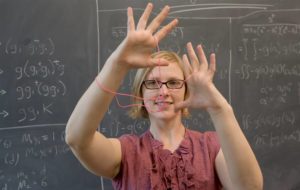
Allison Henrich is an associate professor at Seattle University and the 2015 recipient of the the MAA Alder Award for Distinguished Teaching. She has a keen interest in studying knots from a mathematical perspective and, inspired by conversations with Art Benjamin, she is beginning work on a book with Louis Kauffman on the mathematics of rope tricks.
More information about Allison Henrich is available from Allison’s website.
The lecture took place on Thursday, Sept. 21, 2017, at 7 p.m., in HMC’s Shanahan Center Auditorium.
Abstract
Play is essential for human flourishing. Whether you are a poet or a scientist, a grandparent or a child, play can powerfully enrich your life. For mathematicians, play is essential for building intuition. For undergraduates, play can inspire a desire to get involved in mathematical research. The world of knots provides fertile ground for understanding these connections. Playing games on knot diagrams can give us intuition about knotty structures, while learning about the theory of knots can reveal the “magic” behind rope tricks and excite us to learn more.
Spring 2017, Skip Garibaldi
“Identifying Lottery Scams Using Mathematics and Public Lottery Data”
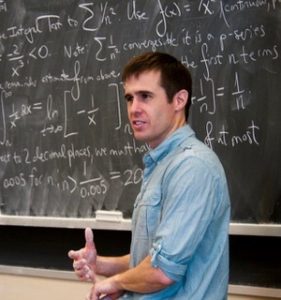
Professor Skip Garibaldi presented the thirteenth lecture in The Michael E. Moody Lecture Series on”Identifying Lottery Scams Using Mathematics and Public Lottery Data.”
Skip Garibaldi is a mathematician known for his work on algebraic groups, especially exceptional groups such as E8; the book Cohomological invariants in Galois cohomology with Alexander Merkurjev and Jean-Pierre Serre; and his work on the lottery, which led to changes in state policy and arrests. Millions of people have seen him talk about his work on 20/20, CNN, and Fox & Friends, and he is a consultant for and part of a museum exhibit about mathematics that has been traveling the country since opening at the Smithsonian in spring 2012.
He is Incoming Director of the Center for Communications Research in La Jolla. Previously he was associate director of the Institute for Pure & Applied Mathematics at UCLA; Winship Distinguished Research Professor in the Department of Mathematics and Computer Science at Emory University; a postdoc at the Swiss Federal Institute of Technology in Zurich (ETH); held visiting positions at Université d’Artois and Université Paris-Nord in France; and been a Gambrinus Fellow at TU Dortmund. In 2014, he was appointed to the Air Force Scientific Advisory Board by the Secretary of Defense.
More information about Skip Garibaldi is available from Skip’s website.
The lecture took place on March 30, 2017, at 7 p.m., in HMC’s Shanahan Center Auditorium.
Abstract
This talk will tell the story of how a journalist, two mathematicians, and a statistician teamed up and used mathematics to identify people who were using the lottery as an adjunct to their illicit activities. The analysis combined old and new mathematics with on-the-ground detective work. The resulting series of journal and newspaper articles led to arrests and changes in state policy, and contributed to the resignation of the head of the Florida lottery. Still, many questions remain to be investigated.
Fall 2016, Karen Saxe
“Mathematics & Social Justice”
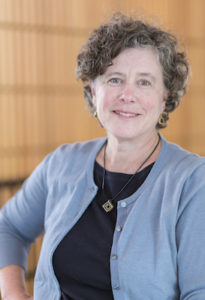
Professor Karen Saxe of Macalester College presented the eleventh lecture in The Michael E. Moody Lecture Series on “Mathematics & Social Justice.”
Karen Saxe is DeWitt Wallace Professor of Mathematics at Macalester College in St Paul, MN. She has been awarded a Distinguished Teaching Award by the Mathematical Association of America, and the Macalester College Excellence in Teaching Award.
She is active with policy and advocacy activities for both the MAA and the Association for Women in Mathematics, and will assume the position as Director of the Washington DC Office of the American Mathematical Society on January 1, 2017, where she will work to connect the mathematics community with Washington decision makers who impact science and education funding.
Karen has been a resource in Minnesota on redistricting, consulting with city governments, and served on the Minnesota Citizens’ Redistricting Commission, created to draw congressional districts following the 2010 census. She also serves on the Advisory Board for Transforming Post-Secondary Education in Mathematics (TPSE Math), an initiative sponsored by Carnegie Corporation of New York and the Alfred P. Sloan Foundation, aiming to effect constructive change in mathematics education at community colleges, 4-year colleges and research universities.
On her most recent sabbatical she served as the 2013–2014 AMS/AAAS Science and Technology Policy Congressional Fellow, working in Congress for MN Senator Al Franken.
More information about Karen Saxe is available from Karen’s website.
The lecture took place onWednesday, Oct. 26, 2016, at 7 p.m., in HMC’s Shanahan Center Auditorium.
Abstract
Societal inequalities pose some of the biggest and most intractable challenges facing our nation today. Can mathematical concepts help us understand and analyze social inequality? What is the relationship between various imbalances in the U.S. today such as those we see in income distribution and political polarization? This talk will explore answers to these questions. We will focus on a few quantitative approaches that mathematicians and political scientists use to measure inequalities. The metrics we will look at include the Gini Index for measuring income inequality, and the Roeck measure for detecting gerrymandering. We’ll also discuss how our political environment and policies can reduce or intensify inequalities in society.
Spring 2016, Andrea L. Bertozzi
“The Mathematics of Crime”
Professor Andrea L. Bertozzi of UCLA presented the tenth lecture in the Michael E. Moody Lecture Series on “The Mathematics of Crime.”
Andrea L. Bertozzi is an applied mathematician with expertise in nonlinear partial differential equations and fluid dynamics. She also works in the areas of geometric methods for image processing, crime modeling and analysis, and swarming/cooperative dynamics. Bertozzi completed all her degrees in Mathematics at Princeton. She was an L. E. Dickson Instructor and NSF Postdoctoral Fellow at the University of Chicago from 1991-1995. She was the Maria Geoppert-Mayer Distinguished Scholar at Argonne National Laboratory from 1995-6. She was on the faculty at Duke University from 1995-2004 first as Associate Professor of Mathematics and then as Professor of Mathematics and Physics. Bertozzi moved to UCLA in 2003 as a Professor of Mathematics. Since 2005 she has served as Director of Applied Mathematics, overseeing the graduate and undergraduate research training programs at UCLA. In 2012 she was appointed the Betsy Wood Knapp Chair for Innovation and Creativity. Bertozzi’s honors include the Sloan Research Fellowship in 1995, the Presidential Early Career Award for Scientists and Engineers in 1996, and SIAM’s Kovalevsky Prize in 2009. She was elected to the American Academy of Arts and Sciences in 2010 and to the Fellows of the Society of Industrial and Applied Mathematics in 2010. She became a Fellow of the American Mathematical Society in 2013. To date she has graduated 28 PhD students and has mentored 39 postdoctoral scholars.
More information about Andrea L. Bertozzi is available from Andrea’s website.
The lecture took place on March 3, 2016, at 7 p.m., in HMC’s Shanahan Center Auditorium.
Abstract
Law enforcement agencies across the country have discovered that partnering with a team of mathematicians and social scientists from UCLA can help them determine where crime is likely to occur. Dr. Bertozzi will talk about the fascinating story behind her participation on the UCLA team that developed a “predictive policing” computer program that zeros-in on areas that have the highest probability of crime. In addition, the use of mathematics in studying gang crimes and other criminal activities will be discussed. Commercial use of the predictive policing program allows communities to put police officers in the right place at the right time, stopping crime before it happens.
Fall 2015, Satyan Devadoss
“The Shape of Nature: Bee, Tree, Origami”
Professor Satyan Devadoss of Williams Collegepresented the ninth lecture in The Michael E. Moody Lecture Series on“The Shape of Nature: Bee, Tree, Origami”.
Satyan Devadoss is a mathematician, a professor at Williams College, a visiting professor at Harvey Mudd (for the 2015–2016 academic year), and holds a PhD from Johns Hopkins. He is an inaugural Fellow of the American Mathematical Society and has received teaching awards from the Mathematical Association of America. His works range from cartography and origami to phylogenetics and art, attracting support from the National Science Foundation, the John Templeton Foundation, the Mellon Foundation, and the Department of Defense. In addition to invitations at Google, Pixar, and LucasFilm, he has held visiting positions at Ohio State, UC Berkeley, the Mathematical Sciences Research Institute, and Stanford.
More information about Satyan Devadoss is available from Satyan’s website.
The lecture took place on Sept. 17, 2015, at 7 p.m., in HMC’s Shanahan Center Auditorium.
Abstract
The renaissance was a time when art and science were not polar opposites, but extensions of one another. With the advent of the enlightenment era, a dualistic tension between visual arts and scientific research was introduced. Today, the study of nature is serving as a bridge between these worlds once again. Heavily infused with imagery, we look at examples at the intersection of modern art and research mathematics, including architectural monuments inspired by the mysteries of honeycomb designs, paintings and visualizations motivated by the genetic data of novels, and paper sculptures spawned from the folding of leaves and proteins.S
Spring 2015, Tim Chartier
“Who’s Number One? From Ranking to Bracketology”
Professor Tim Chartier of Davidson College presented the ninth lecture in The Michael E. Moody Lecture Series on “Who’s Number One? From Ranking to Bracketology”.
Associate Professor of Mathematics and Computer Science at Davidson College, Tim Chartier, specializes in applied linear algebra in the fields of data analytics and partial differential equations. In 2014, he was named the inaugural Math Ambassador for the Mathematical Association of America (MAA), which also recognized his ability to communicate math with a national teaching award. His research and scholarship were recognized with an Alfred P. Sloan Research Fellowship. Published by Princeton University Press, Tim wroteMath Bytes: Google Bombs, Chocolate-Covered Pi, and Other Cool Bits in Computingand coauthored the textbookNumerical Methods: Design, Analysis, and Computer Implementation of Algorithms. Tim fields mathematical questions for theSports Scienceprogram on ESPN, and has also been a resource for a variety of media inquiries, which include appearances with NPR, the CBS Evening News,USA Today, andThe New York Times.
More information about Tim Chartier is available from Tim’s website.
The lecture took place on March 6, 2015, at 7 p.m., in HMC’s Shanahan Center Auditorium.
Abstract
“Who’s number one?” is an inherent and often debated question in sports. Ranking algorithms supply mathematical answers to such questions. They can and are used to choose teams for the playoffs. They can also be used in predictive analysis. Who will win the next game? Who will win a tournament? This talk will present current and recent sports analytics research. A variety of questions will be explored. For example, how can one integrate late season momentum? Does it help to consider home field advantage? We will see how such research created brackets for March Madness that beat over 90% of over 8 million brackets submitted to ESPN’s online tournament.
Fall 2014, Trachette L. Jackson
“Mathematical Models of Tumor Angiogenesis”
Professor Trachette L. Jackson of the University of Michigan presented the eighth lecture in The Michael E. Moody Lecture Series on“Mathematical Models of Tumor Angiogenesis.”
Trachette L. Jackson earned her PhD in Applied Mathematics in 1998 from the University of Washington, and is currently a Full Professor of Mathematics at the University of Michigan. Dr. Jackson is an award-winning teacher scholar whose research in mathematical oncology has received international attention. In 2003, she became second African American woman to receive the prestigious Alfred P. Sloan Research Award in Mathematics; in 2005 she received a James S. McDonnell 21st Century Scientist Award; in 2008 Diverse Magazine honored her as one of the year’s Emerging Scholars; and in 2010 she received the Blackwell-Tapia Prize. The main focus of Dr. Jackson’s research is combining mathematical modeling, numerical simulation and in vivo tumor vascularization experimentation to gain deeper understanding of tumor growth and vascular structure at the molecular, cellular, and tissue levels. Dr. Jackson has built her career on collaborative research and educational activities that cut across traditional disciplinary boundaries, and envisions that this type of research will eventually change the face of cancer research.
More information about Trachette L. Jackson is available from Trachette’s website.
The lecture took place on Friday, Oct. 10, 2014, at 7 p.m., in HMC’s Shanahan Center Auditorium.
Abstract
Cancer is the collective name given to an entire class of diseases characterized by rapid, uncontrolled cell growth. To ensure continued growth, tumors must acquire a continuous supply of nutrients and the ability to export metabolic waste. They accomplish this by recruiting new blood vessels from the nearby existing vasculature, a process known as tumor-induced angiogenesis. Angiogenesis is a critical bifurcation point in cancer progression as it provides the necessary blood supply for the growth of solid tumors beyond a few millimeters in diameter. The angiogenic cascade is an extremely complex, yet well-ordered series of events involving biochemical and biomechanical signals that operate across several temporal and spatial scales. In this talk, classical and current mathematical models of tumor angiogenesis will be explored and recent advances will be highlighted.
Spring 2014, Anette (Peko) Hosoi
“From Razor Clams to Robots: The Mathematics Behind Biologically Inspired Design”
Professor Anette (Peko) Hosoi of MIT presented the seventh lecture in The Michael E. Moody Lecture Series on “From Razor Clams to Robots: The Mathematics Behind Biologically Inspired Design.”
Anette (Peko) Hosoi is an exceptional and innovative teacher, an inspiring mentor for women in engineering and an outstanding communicator of science. Her research interests include fluid mechanics, bio-inspired design, and locomotion, with a recent focus on optimization of crawling gastropods, digging bivalves, swimming microorganisms, and soft robotics. She is a recognized international leader in the study of the hydrodynamics of thin fluid films and in the nonlinear physical interaction of viscous fluids and deformable interfaces. Her work spans multiple disciplines, including physics, biology, and applied mathematics, and is being used to guide the engineering design of robotic crawlers and other mechanisms.
More information about Anette (Peko) Hosoi is available from Anette’s website.
The lecture took place on Thursday, April 3, 2014, at 7 p.m., in HMC’s Shanahan Center Auditorium.
Lecture Poster
Abstract
Many natural systems have evolved to perform certain tasks—climbing, sensing, swimming—as perfectly as possible within the limits set by the laws of physics. This observation can be used both to guide engineering design and to gain insights into the form and function of biological systems. We will consider both of these themes in the context and crawling snails, diffing clams and swimming microorganisms. We will discover how and analysis of the physical principles exploited by snails and clams leads to the development of novel robotic diggers and crawlers, and explore the role of mathematics in the design, control, and assessment of unconventional robotic systems.
Fall 2013, Jennifer Quinn
“Mathematics to DIE for: The Battle Between Counting and Matching”
Professor Jennifer Quinn of the University of Washington, Tacoma presented the sixth lecture in The Michael E. Moody Lecture Series on “Mathematics to DIE for: The Battle Between Counting and Matching.”
Jennifer Quinn is a professor of mathematics at the University of Washington Tacoma. She earned her BA, MS, and PhD from Williams College, the University of Illinois at Chicago, and the University of Wisconsin, respectively. She has taught in and chaired the mathematics department at Occidental College before moving to UW Tacoma where she has just completed serving as Associate Director of Interdisciplinary Arts and Sciences. She has held many positions of national leadership in mathematics including as Executive Director for the Association for Women in Mathematics, co-editor of *Math Horizons,* and, currently, Second Vice President of the Mathematical Association of America (MAA). She received one of MAA’s 2007 Haimo Awards for Distinguished College or University Teaching, the MAA’s 2006 Beckenbach Book award forProofs That Really Count: The Art of Combinatorial Proof, co-authored with Arthur Benjamin. As a combinatorial scholar, Jenny thinks that beautiful proofs are as much art as science. Simplicity, elegance, and transparency should be the driving principles.
The lecture took place on Friday, Oct. 11, 2013, at 7 p.m., in HMC’s R. Michael Shanahan Center for Teaching and Learning Lecture Hall.
Abstract
Positive sums count. Alternating sums match. So which is “easier” to consider mathematically? This talk is one partperformance artand three parts combinatorics. The audience will judge a combinatorial competition between the competing techniques. Be prepared to explore a variety of positive and alternating sums involving binomial coefficients, Fibonacci numbers, and other beautiful combinatorial quantities. How are the terms in each sum concretely interpreted? What is being counted? What is being matched? Do alternating sums always give simpler results? You decide.
Spring 2013, Ravi Vakil
“The Mathematics of Doodling”
Professor Ravi Vakil of Stanford University presented the fifth lecture in The Michael E. Moody Lecture Series on “The Mathematics of Doodling.”
Ravi Vakil is a Professor of Mathematics at Stanford, where he is also the Robert K. Packard University Fellow and the David Huntington Faculty Scholar. He is an algebraic geometer, and his work touches on many other parts of mathematics, including topology, string theory, applied mathematics, combinatorics, number theory, and more.
He was born in Toronto, Canada, and studied at the University of Toronto, where he was a four-time Putnam Fellow (winner of the Putnam competition). He received his PhD from Harvard in 1997, and taught at Princeton and MIT before moving to Stanford in 2001. He has received the Dean’s Award for Distinguished Teaching, the AMS Centennial Fellowship, a Sloan Research Fellowship, and the Presidential Early Career Award for Scientists and Engineers, and numerous other awards. He is also currently the Mathematical Association of America’s Pólya Lecturer 2012–2014, and an informal advisor to the new website mathoverflow. He works extensively with talented younger mathematicians at all levels, from high school (through math circles, camps, and olympiads), through recent PhDs.
More information about Ravi Vakil is available from Ravi’s website.
The lecture took place on Friday, April 19, 2013, at 7 p.m., in HMC’s Galileo McAlister lecture hall.
Lecture Poster
Abstract
Doodling has many mathematical aspects: patterns, shapes, numbers, and more. Not surprisingly, there is often some sophisticated and fun mathematics buried inside common doodles. I’ll begin by doodling, and see where it takes us. It looks like play, but it reflects what mathematics is really about: finding patterns in nature, explaining them, and extending them. By the end, we’ll have seen some important notions in geometry, topology, physics, and elsewhere; some fundamental ideas guiding the development of mathematics over the course of the last century; and ongoing work continuing today.
Spring 2012, Andrew Belmonte
“The Mathematics of Strings, Spaghetti, and Splashes”
Professor Andrew Belmonte of Pennsylvania State University presented the fourth lecture in The Michael E. Moody Lecture Series on“The Mathematics of Strings, Spaghetti, and Splashes”
Andrew Belmonte has long worked at the intersection of mathematics and the world to which it can be applied. He received his PhD in Physics at Princeton University (1994), and was awarded a Chateaubriand Fellowship and an NSF International Fellowship to study at the Institut Non-Lineaire de Nice in France for two years, after which he was a postdoc at the University of Pittsburgh. In 1998 he became a faculty member at Penn State University, where he currently works in the W.G.Pritchard Laboratories. He was the recipient of an Alfred P. Sloan Fellowship (2000), an NSF CAREER Award (2001), and has been a visiting professor at the ESPCI in Paris, France (2004) and at Harvard University (SEAS, 2007).
More information about Andrew Belmonte is available from Andrew’s website.
The lecture took place on Friday, March 23, 2012, at 7 p.m., in HMC’s Galileo McAlister lecture hall.
As with all of the college’s evening speaker lectures, the talk was aimed at a wide audience and was open to all.
Abstract
If, as Galileo said, the book of the universe is written in the language of mathematics, it is also true that many new chapters in the book of mathematics have been inspired by nature. I will explore this connection through several puzzles from the ordinary experiences of everyday life: why is it difficult to break dry spaghetti in half? Why do things like extension cords, shoe laces, and earbuds always get tangled up in knots? How does a falling droplet splash onto the floor? In each case, careful experimentation leads to mathematical answers, generating interesting new questions in the process.
Fall 2011, Robert L. Devaney
“Chaos Games and Fractal Images”
Professor Robert L. Devaney of Boston University presented the third lecture in The Michael E. Moody Lecture Series on“Chaos Games and Fractal Images.”
He is the author of over one hundred research papers in the field of dynamical systems as well as a dozen pedagogical papers in this field, and has delivered over 1500 invited lectures on dynamical systems and related topics in all fifty US states and over thirty countries on six continents worldwide. He has also been the “Chaos Consultant” for several theaters’ presentations of Tom Stoppard’s playArcadiaand in 2007 he was the mathematical consultant for Kevin Spacey’sTwenty One.
Bob has received many awards for teaching and research from institutions including Boston University, the MAA, and the NSF, and directs the NSF’s Dynamical Systems and Technology Project, which aims to show students and teachers how ideas from modern mathematics such as chaos, fractals, and dynamics, together with modern technology, can be used effectively in the high school and college curriculum.
He is president-elect of the MAA in 2012, and will serve as president in 2013–2014.
More information about Bob Devaney is available from the biographical sketch on Bob’s website.
The lecture took place on Friday, Sept. 30, 2011, at 7 p.m., in HMC’s Galileo McAlister lecture hall.
As with all of the college’s evening speaker lectures, the talk was aimed at a wide audience and was open to all.
Abstract
In this lecture we will describe some of the beautiful images that arise from the “Chaos Game”. We will show how the simple steps of this game produce, when iterated millions of times, the intricate images known as fractals. We will describe some of the applications of this technique used in data compression as well as in Hollywood. We will also challenge students present to “Beat the Professor” at the chaos game and maybe win his computer.
Fall 2010, Jonathan Rogness
“When Mathematics Meets Youtube”
Professor Jonathan Rogness of the University of Minnesota presented the second lecture in the The Michael E. Moody Lecture Series on“When Mathematics Meets YouTube.”
Jonathan Rogness is an assistant professor of mathematics at the University of Minnesota. A topologist by training, he has become well-known for his mathematical visualizations for use in and outside of the classroom. He was recently named the new director of the university’s Mathematics Center for Educational Programs (MathCEP), which runs one of the nation’s premier accelerated mathematics programs for middle- and high-school students.
The lecture took place on Friday, Nov. 19, 2010, at 7 p.m., in HMC’s Galileo McAlister lecture hall.
As with all of the college’s evening speaker lectures, the talk will be aimed at a wide audience and will be open to all.
Abstract
What happens when 1.7 million people encounter high-level mathematics on YouTube? “Möbius Transformations Revealed” is a short film that illustrates the beauty of Möbius Transformations and shows how moving to a higher dimension makes them easier to understand. After winning an award from the National Science Foundation andSciencemagazine the video went viral, with unexpected and entertaining results. This talk will describe the behind-the-scenes making of the movie, explore the mathematics it illustrates, and show the reactions of YouTube users who discover the visual allure of mathematics.
Spring 2010, Lesley Ward
“The Linear Algebra of Internet Search Algorithms”
Professor Lesley Ward of the University of South Australia presented the inaugural lecture in The Michael E. Moody Lecture Series on “The Linear Algebra of Internet Search Algorithms.”
Lesley Ward is a recipient of the MAA’s Alder Award for Distinguished Teaching, and has held a Prize Teaching Fellowship at Yale, a Postdoctoral Fellowship at the Mathematical Sciences Research Institute (MSRI), and an Evans Instructorship at Rice. Her research is in complex analysis, harmonic analysis, and industrial applications of mathematics. She is proud to have been a member of the HMC Mathematics Department for nine years, before moving to the University of South Australia in 2006.
The lecture took place on Sunday, May 2, 2010, at 4:30 p.m., in HMC’s Galileo McAlister lecture hall.
As with all of the college’s evening speaker lectures, the talk was aimed at a wide audience and was open to all.
Abstract
How do web-search algorithms work? Early algorithms just counted the number of times a query word appeared in a given webpage. More recent algorithms rely on “link analysis”, which aims to mine the collective wisdom encoded in the network of links: people make judgments about how useful a given page is for a given topic, and they express these judgments through the hyperlinks they choose to put on their own pages. I will show how linear algebra forms the common underpinning of three link-analysis algorithms for web search: PageRank, HITS, and SALSA. I will also discuss a modification of HITS that originated from a Mathematics Clinic at Harvey Mudd College, and is joint work with several people, including Harvey Mudd College undergraduates.
Michael E. Moody
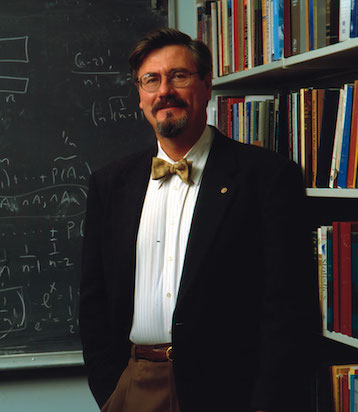
The Harvey Mudd College Department of Mathematics established a lecture series in honor of Michael Moody.
Under Moody’s leadership as chair from 1996–2002, the mathematics department revised its curriculum, rejuvenated the senior-thesis program and tripled the number of majors. Moody was a guiding force that led to the department being awarded the American Mathematical Society’s inaugural award for an Exemplary Program or Achievement in a Mathematics Department in 2006.
Moody also founded an evening lecture series that brought speakers to the College who illuminated the joy, wonder and applicability of mathematics and that attracted hundreds of students. The lecture series, now in Moody’s name, continues this tradition.
Moody passed away in January 2010. Our department—and many students, faculty, staff and friends within its community—have benefited from his extraordinary legacy.